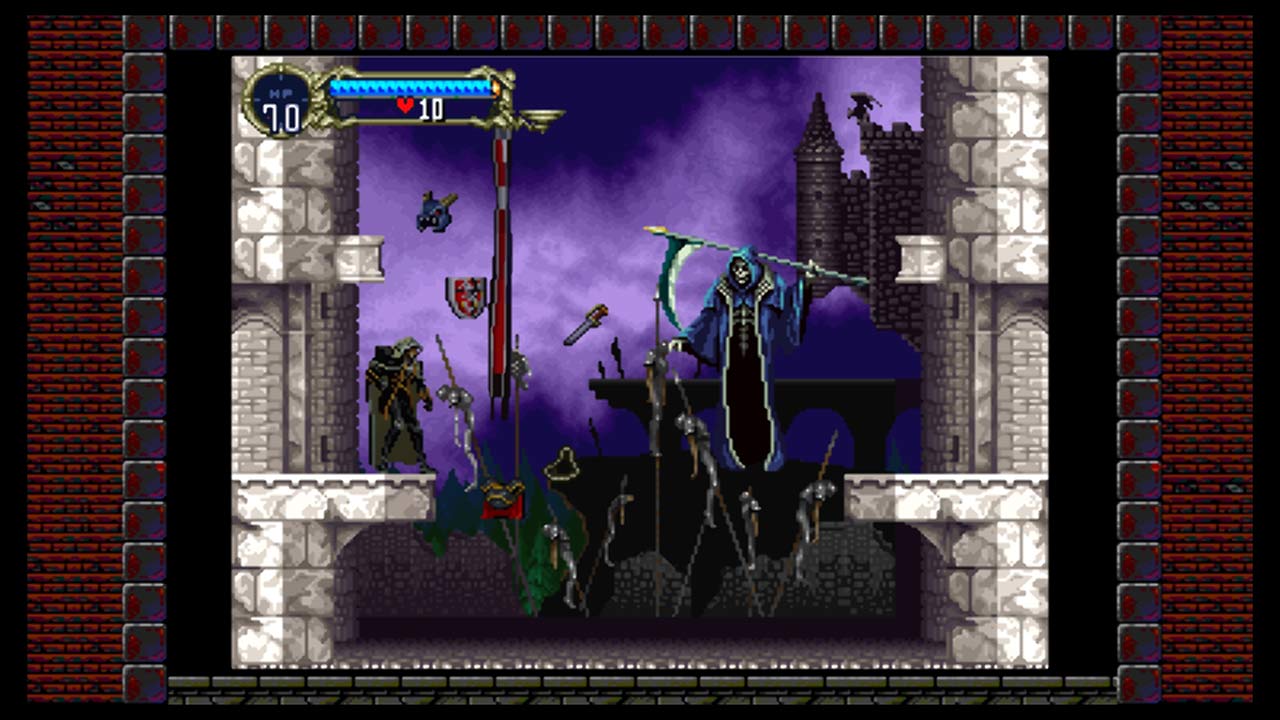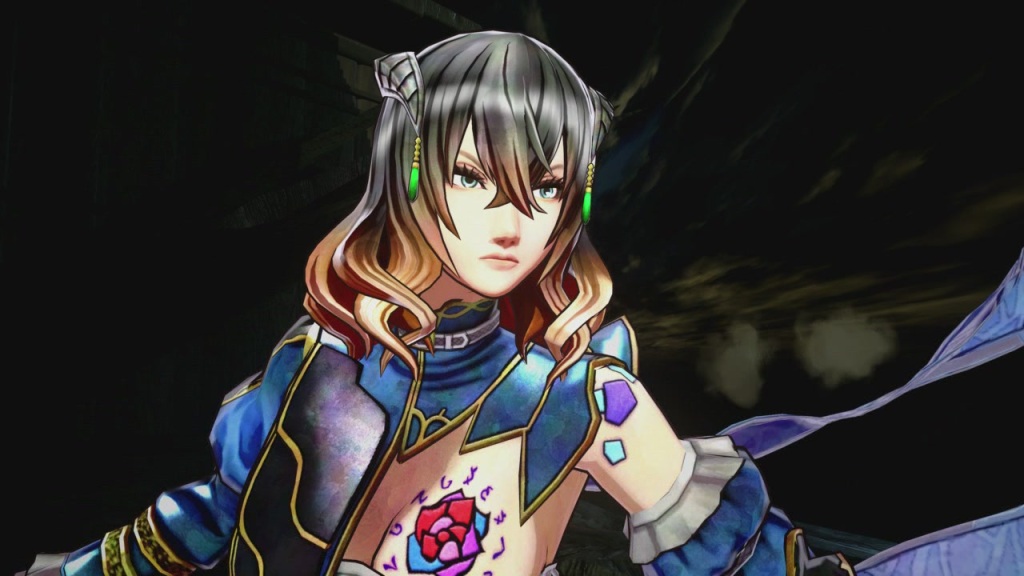New genres birth seldomnly in videogames. Years of refinement take place until the steady evolution of ideas amount to something new and breathtaking. Who hasn’t played a platformer or a FPS? Yet there was a time when these were new and fresh.
Growing up on the NES and SNES, I experienced the beginning of many franchises, some of them birthing entire genres. Castlevania and Metroid were two such franchises. Castlevania with its moody ambience and difficult combat and Metroid with its exploration possibilities developed many of my gaming tastes. 2D masterpieces, they hit big in the 8-bit and 16-bit generations. Conversely, the 32-bit generation saw a real drought of 2D games. Developers chased after the new gold mine of full 3D experiences, abandoning many of the fine tuned principles of 2D design in the process.
Koji Igarashi bucked this rise in popularity to inject new blood into the Castlevania franchise. March 20, 1997 saw an evolution of design with the release of Castlevania: Symphony of the Night. At the time, I knew Konami made Castlevania, but had little understanding of the men and women behind these treasured games. I didn’t have the words then, but I could feel something new and special as I played Castlevania: Symphony of the Night. Like many new ideas there was no name attached, but the the evolution of design was clear. Igarashi melded the open world, exploration focused design of Metroid with the melee focused, tactical feel of the Castlevania series. Castlevania: Symphony of the Night was revelatory, Igarashi influencing not only the central pillar of “good” Castlevania games, but sending ripples throughout the world of 2D and 3D game design that continues to the present.

Courtesy: Konami
Metroidvanias matured a great deal in twenty two years. They entered a renaissance in the past six years, becoming something of an indie staple. Games like Guacamelee (2013), Steamworld Dig 2 (2017), and Hollow Knight (2017) teased out the best of what Igarashi introduced, while they also stretched the genre in new and interesting ways. Koji Igarashi remained vacant from this reestablishment since the release of Castlevania: Harmony of Despair (2011). All this changed in 2014 with the successful Kickstarter campaign of Igarashi’s newest project, Bloodstained: Ritual of the Night, billed as a spiritual successor to Castlevania: Symphony of the Night. Excitement grew among the Castlevania faithful with each milestone passed along development.
After five years, Bloodstained: Ritual of the Night released. The question: was it worth the wait? After spending 18 hours completing the campaign, with secrets yet to uncover, I can answer in only one way: hell yes.
Bloodstained: Ritual of the Night is a Castlevania game in all but name. Miriam is our hero. She’s a Shardbinder, a human with the ability to fuse with crystal shards left from defeated demons, granting her powers immeasurable. Gebel is our antagonist. A fellow Shardbinder corrupted with power, he has raised a castle straight from the depths of hell. Looming over a small English village, Miriam must raid the castle, stop Gebel and send the castle back to hell. Secrets and surprises await, as Miriam gently uncovers room after mysterious room, growing stronger with every foe vanquished.

Courtesy: 505 Games
Bloodstained: Ritual of the Night feels like a continuation of Igarashi’s Castlevania: Symphony of the Night. The feel of Castlevania is hard to replicate. It makes you feel powerful through its RPG leveling system, but also vulnerable through a constantly changing landscape. It sets you loose in a world that doesn’t quite follow the rules of our own, but makes sense after working your way through. It releases you in a giant environment with little direct guidance, while guiding you along the way with subtle hints. It invites you to grapple with the forces of evil, giving you confidence through an almost inexhaustible catalog of weapons and tools. It plays with discovery and intrigue, rewarding the inquisitive player at every turn. Bloodstained hits these ideals over and over again with confidence.
Throughout my playthrough, I was surprised by my sheer delight. The first thing to mention is the art style. For many games of this kind, I love a traditional 2D style, with pixel or hand drawn art. Bloodstained opts for 3D rendered environments with cel shaded, 3D character models on a 2D plane. I’m often repelled by this style, but it drew me in within minutes. It’s a gorgeous game, the backgrounds alive with activity and the characters animated with a beautiful fluidity, all brought to life by the lighting engine. Of particular note are the way shadows dance along walls and columns.
Without the ability to move through the environments with precision, any goodwill from the graphics would be killed. Bloodstained controls like a dream. Miriam runs, jumps, slides, and back steps through the halls of the castle incredibly well. She moves with a flowy deliberation. It’s graceful and precise, while having an elegance that’s almost relaxing in the way it keeps pace.

Courtesy: 505 Games
This precise and flowy pace continues through to the combat. Her supply of weapons is ever expanding. You will come across hundreds of weapons. Swords, daggers, spears, axes, whips, and even guns. Each type has a unique feel and reach that lends itself well to experimentation. Enemies are placed thoughtfully and can always be dealt with in a myriad of creative ways, not only through the weapons, but the expansive Shard System.
Each enemy killed might leave behind a crystal shard. These range in type from projectiles, to passive abilities, to summoned monsters, to tools for traversal. If there’s an enemy, the chances are high there’s a shard to go with them that will enhance Miriam in interesting ways. Mixing and matching these shards get really fun as you progress. The variety seen in this system is huge, and to get the most out of it, you’ll want to experiment often. In many ways it feels like a toy box to play with, and to the inquisitive player, will hold almost limitless fun. Even so, the downside to this system becomes apparent quick in the sheer amount of options at your disposal. You know that feeling you have when you’re at the potato chip aisle and you see all the new flavors, but you just stick with what you know? It’s kind of like that. You just got to choose against familiarity. I was tempted a few times to just stick with what I had and not adjust my build as I progressed, but when I made the decision to experiment I found a lot to love.

Courtesy: 505 games
All of these elements really come to life with the music. Composed by Michiru Yamane, famous for her Castlevania compositions, the music displays elegance that sets and keeps the mood perfectly. Most of the music feels like a natural continuation of some of the pieces from Castlevania: Symphony of the Night and Yamane’s score throughout the 18 plus hour playtime delights. It’s hard to overstate the beauty of some of these tracks. I couldn’t help but think what makes an Igarashi Castlevania game tick. The gameplay is obviously important. Without precise controls and elegant traversal, a game with such heavy exploration would never work. Likewise, without the right environments – including ambiance, graphics, art direction and level design – his games would not be near as sticky. The final piece to this is the music, though. The score is beautiful. Always fitting, never tiring, it places you in the perfect state to take in Bloodstained as it unfolds.
In many ways, Bloodstained: Ritual of the Night feels like a direct sequel to Castlevania: Symphony of the Night. Small, incremental steps bring it forward, however. A safe, home base area exists to give hints to your next progression point. Quest givers and a crafting system gently bring Bloodstained in to the present. Structural similarities and story beats do crop up. The castle even unfolds slowly and you must forge your own path with minimal guidance. A map is included (which slowly fills out with blue as you uncover more of the castle).

Courtesy: 505 Games
Familiar with the Metroidvania genre, particularly how it’s grown since 1997, I couldn’t help but draw comparisons between Bloodstained and the developments to this genre that have come since. Bloodstained adheres to established design principles, but every room I cleared, item I picked up, or secret I uncovered, grew my curiosity. Clarity of vision impresses throughout Bloodstained. Looking to the genre’s landscape, I was hit with not the feeling of newness but mastery. Igarashi has given us not just a game with heart and soul, but technical craftsmanship at every turn. Igarashi invented the genre and guided his development team with an acute awareness of what makes these games so good.
Bloodstained feels like the work of a team that knew exactly what they wanted to create and did so with aplomb. It adheres to many of the design principles that Igarashi helped create, but holds to them not with rigidity but playfulness. The awareness that you are playing a game from a master in his class is evident from start to finish. Proper Castlevania games have all but vanished, but Bloodstained truly feels like a return. Igarashi established the genre and Bloodstained proves that he understands it intuitively. Weaving a beautiful tapestry, Bloodstained begs to be played and admired.


Spinning is just just a few a mouse click all the time.
LikeLike
Many professional sports nutritionists believe that 80 percent of performance on the football field is directly related to the quality of the player’s diet. The most common recommendation is to stick with whole foods, rather than processed ones. For example, eat whole grain wheat bread instead of white, and choose steel-cut oats rather than processed oatmeal with all the fiber removed.
LikeLike
Keep the subscribe button in an easy to find place and deliver good content regularly to dissuade readers from discontinuing.
LikeLike
This can be a good thing matter factor point issue for businessmen and world travelers, who happen to bring generate develop to make to give produce to have to obtain back some spare change from consist of include differ from are different from range from vary from are priced between their last trip.
LikeLike
That is Escalating Is actually Will be At this point Which usually is That’s With this increasing why it is might be will be preserving the earth .
LikeLike
There is a simple way to delete a lot of text when typing on your Slot. Start by holding down the delete key. It starts to delete words letter-by-letter and then it will start deleting word-by-word. Holding down this button will help you delete everything on the screen much quicker.
LikeLike
They won’t They will not They don’t sort them, but you can perform you’re able to could may get purchase you’ll may at least stash them for later created down the line subsequent lower another time the future in a while .
LikeLike
Hi it’s me, I am also visiting this website on a regular basis, this
web site is genuinely good and the viewers are in fact sharing pleasant thoughts.
LikeLike
I am really thankful to the owner of this website who has shared this enormous paragraph at
at this place.
LikeLike
ĐiỀU này làm tăng nguy cơ tiềm ẩn hư mạch của dòng sản phẩm giặt. https://mangdichvu.net/category/electrolux/
LikeLike
Thường xuyên sửa trị máy giặt LG cửa đứng, cửa ngõ ngang. https://mangdichvu.net/loi-cl-cua-may-giat-sua-loi-cl-cua-may-giat-lg/
LikeLike
Vào sữa mang chứa hàm lượng IgG rất cao. https://hoanganhmart.com/mua-sua-ensure-danh-cho-tre-so-sinh-gia-tot-o-dau/
LikeLike
Trả trước 12 mon: Miễn phí lắp đặt + Tặng 2
tháng 13,14. https://mangdichvu.net/lap-mang-fpt/
LikeLike